#litocranius
Text

Gerenuk (Litocranius walleri), male, standing to feed on tasty leaves, family Bovidae, Samburu National Reserve, Kenya
Photograph by @mogenstrolle
281 notes
·
View notes
Text

Southern gerenuk Litocranius walleri walleri
Observed by gbrunvoll, CC BY-NC
22 notes
·
View notes
Text

Gerenuk
Litocranius walleri
By Nathan Rupert
22 notes
·
View notes
Text
anyway Cephalopachus bancanus, Spea bombifrons, Leopardus wiedii; Diodon nicthemerus, Enallagma cyathigerum, Caprimulgus europaeus (?); Chimaera monstrosa, Nymphargus cochranae, Pteromys momonga; Eonycteris spelaea, Ensatina eschscholtzii, Hexanchus griseus; Tenodera sp. (?), Siderea thysoidea, Nycticebus javanicus; Xenophthalmichthys danae, Eulemur flavifrons, Rossia pacifica; Imantodes cenchoa, Litocranius walleri, Salticus scenicus; Correlophus ciliatus, Gigantocypris sp., Tragulus kanchil; Odontodactylus scyllarus, Pusa sibirica, Nyctibius griseus.
4 notes
·
View notes
Photo

Southern Gerenuk (Litocranius walleri walleri) at the Saint Louis Zoo https://www.instagram.com/p/CdzFscVLaVB/?igshid=NGJjMDIxMWI=
0 notes
Photo
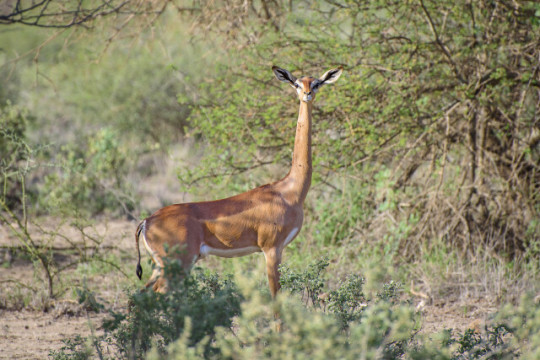
Southern gerenuk (Litocranius walleri walleri)
Photo by Cláudio Dias Timm
#southern gerenuk#gerenuk#litocranius walleri walleri#litocranius walleri#litocranius#antilopini#antilopinae#aegodontia#bovidae#pecora#ruminantia#cetruminantia#artiofabula#artiodactyla#scrotifera#laurasiatheria#boreoeutheria#eutheria#mammalia#tetrapoda#vertebrata#chordata
58 notes
·
View notes
Photo

GERENUK Male Preening Tail Litocranius walleri ©Laura Quick Gerenuk are also known as the giraffe gazelle, is a long-necked antelope found in the Horn of Africa and the drier parts of East Africa.Primarily a browser, the gerenuk feed on foliage of bushes as well as trees, shoots, herbs, flowers and fruits. It can reach higher branches and twigs better than other gazelles and antelopes by standing erect on its hind legs and elongating its neck; this helps it reach over 6-½ feet (2 meters) above the ground. Acacia species preferred, while evergreen vegetation forms the diet during droughts. The pointed mouth assists in extracting leaves from thorny vegetation. The gerenuk does not drink water regularly. #gerenuk#litocranius walleri#©laura quick#east africa#herbivore#hoofstock#african#giraffe gazelle#foliverous#los angeles zoo and botanical gardens#loangeleszoo #lazoo #glaza #juvenile https://www.instagram.com/p/B6E8ucsnIKa/?igshid=27153l10zgqu
#gerenuk#litocranius#©laura#east#herbivore#hoofstock#african#giraffe#foliverous#los#loangeleszoo#lazoo#glaza#juvenile
5 notes
·
View notes
Photo
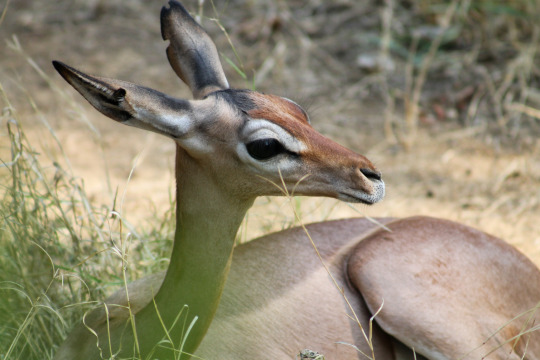
Gerenuk (litocranius walleri)
taken at the Los Angeles Zoo in Los Angeles, California
status: near threatened
A very neat species that I have struggled to get a nice photography of until today! These guys have some strange long necks with a very small head for eating foliage out of reach of other antelope species.
#gerenuk#Litocranius walleri#animal#los angeles zoo#los angeles#zoo#wildlife#photo#photography#canon#canon rebel eos t3
10 notes
·
View notes
Photo

GERENUK (Juvenile)
Litocranius walleri
©Laura Quick
Gerenuk are also known as the giraffe gazelle, is a long-necked antelope found in the Horn of Africa and the drier parts of East Africa.Primarily a browser, the gerenuk feed on foliage of bushes as well as trees, shoots, herbs, flowers and fruits. It can reach higher branches and twigs better than other gazelles and antelopes by standing erect on its hind legs and elongating its neck; this helps it reach over 6-½ feet (2 meters) above the ground. Acacia species preferred, while evergreen vegetation forms the diet during droughts. The pointed mouth assists in extracting leaves from thorny vegetation. The gerenuk does not drink water regularly.
Other posts you might like:
Genenuk chewing gif
Male Gerenuk
Gerenuk browsing for higher branches
#gerenuk#litocranius walleri#©laura quick#east africa#herbivore#hoofstock#african#giraffe gazelle#foliverous#los angeles zoo and botanical gardens#los angeles zoo#lazoo#glaza#juvenile
3 notes
·
View notes
Photo



Gallavanting with Gerenuks
The gerenuk, or giraffe gazelle (Litocranius walleri), is a species of long-necked antelope that lives in the dry savannahs and woodlands of eastern Africa. They can thrive in a variety of habitats, as they have a wide diet. In addition to grasses, shrubs, and flowers, giraffe gazelles use their long legs and necks to reach higher tree branches, giving it access to food unavailable to other herbivores in the area. In addition, the gerenuk does not rely on free-standing water for hydration, as it can absorb water from the plants it eats. This allows L. walleri to thrive in generally arid environments and survive through droughts.
Like most antelope species, L walleri is most active during the day. Females live in small groups of about 10 and will roam between the territories of solitary males. Individuals spend most of their time grazing, though often one member of the group will stay on the lookout for predators. When threatened by predators such as lions, cheetahs, leopards, or hunting dogs, gerenuks will freeze and their coloring allows them to blend in well to their surroundings. In addition, their long legs allow them to run at speeds up to 40 mph in short bursts.
As fitting to its name, the giraffe gazelle is quite tall. At shoulder height they stand between 80-105 cm tall, and when standing on their hind legs they can reach over 2m. Despite their height, individuals are relatively light, weighing only 29-58kg. Males tend to be larger than females, and sport curved horns. Otherwise both sexes look the same, generally tan or brown with white around the eyes and along the underside.
Females will breed once every one to two years, although there is no set mating season. When a male wants to mate, he will perform a complex ritual around the desired female which includes kicking her with his forelegs and sniffing her urine. Pregnancy lasts about seven months, after which females give birth to only one offspring. The young giraffe gazelle will nurse anywhere from 12 to 18 months; male young tend to linger longer than females but will leave once they reach sexual maturity at about 2 years old. In the wild, the gerenuk can live up to 12 years.
Conservation status: The IUCN lists the gerenuk as Near Threatened. This species was never common within its range, but recent reductions to its natural habitats have reduced populations. Many parks consider them protected and there are some breeding programs in place to maintain numbers.
Photos
Diana Robinson
Heather Paul
Frederick Salein (via Wikipedia)
#gerenuk#Artiodactyla#Bovidae#antelopes#true antelopes#ruminants#even-toed ungulates#ungulates#mammals#Savannahs#savannah mammals#grasslands#grassland mammals#deciduous forests#deciduous forest mammals#africa#east africa#animal facts#zoology#biology
223 notes
·
View notes
Text
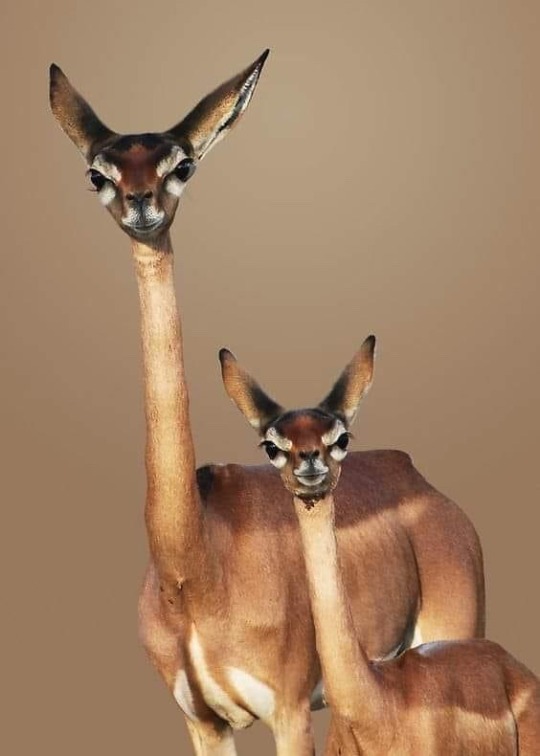
Gerenuk (Litocranius walleri), mother and calf, family Bovidae, Samburu National Reserve, Kenya
Photograph by Michael Sheridan
209 notes
·
View notes
Text

Northern gerenuk Litocranius walleri sclateri
Observed by markuslilje, CC BY-NC-ND
7 notes
·
View notes
Text

Gerenuk - Litocranius walleri, Tsavo East National Park
By Peter Steward
#peter steward#photographer#gerenuk#litocranius walleri#tsavo east national park#animal#mammal#wildlife#nature#flickr
12 notes
·
View notes
Text
Animal of the Day!
Gerenuk (Litocranius walleri)
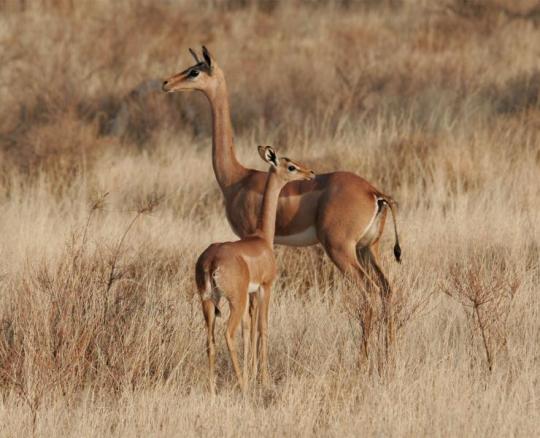
(Photo from African Wildlife Foundation)
Conservation Status- Near Threatened
Habitat- Africa
Size (Weight/Length)- 39 kg; 149.3 cm
Diet- Leaves; Flowers; Fruit
Cool Facts- At first glance, a gerenuk may look more similar to a small, unspotted giraffe than an antelope. The gerenuk has extremely slender legs and a long neck that it puts to good use. Unlike most grazing antelopes, gerenuk are browsers meaning that they prefer trees and bushes. They are able to balance on their hind legs for considerable periods of time as they stretch their entire body and necks upwards and stand at nearly 2 meters tall to eat plants out of reach of most herbivores. They live in small herds to prevent gaining attention from predators, such as leopards and cheetahs, that would take advantage of their vulnerable state of standing on their hind legs.
Rating- 11/10 (Neck tooooooooooo long.)
#Animal of the day#Animals#Mammals#Monday#December 20#Gerenuk#biology#science#conservation#the more you know
42 notes
·
View notes
Text
Giraffe Gazelle!
The Gerenuk, also sometimes called the giraffe Gazelle are the sole members of the genus Litocranius
They get their name from their long neck
They use this neck as well as standing on their back legs to be able to reach leaves that are out of reach for other antelope species
If you have read this far why not follow us @animalfacthub for daily animal facts and pics!
-
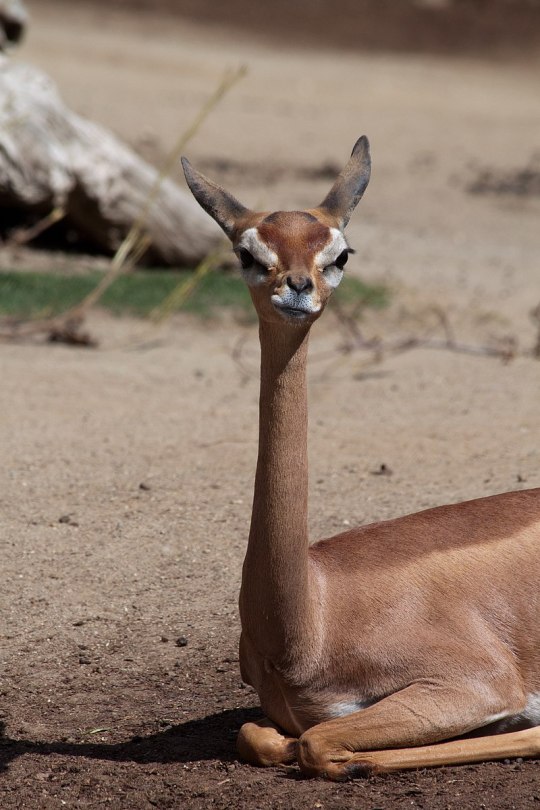
📷1: “Gerenuk (5656497954).jpg” by Tim Sackton on Wikimedia Commons (CC BY-SA 2.0)
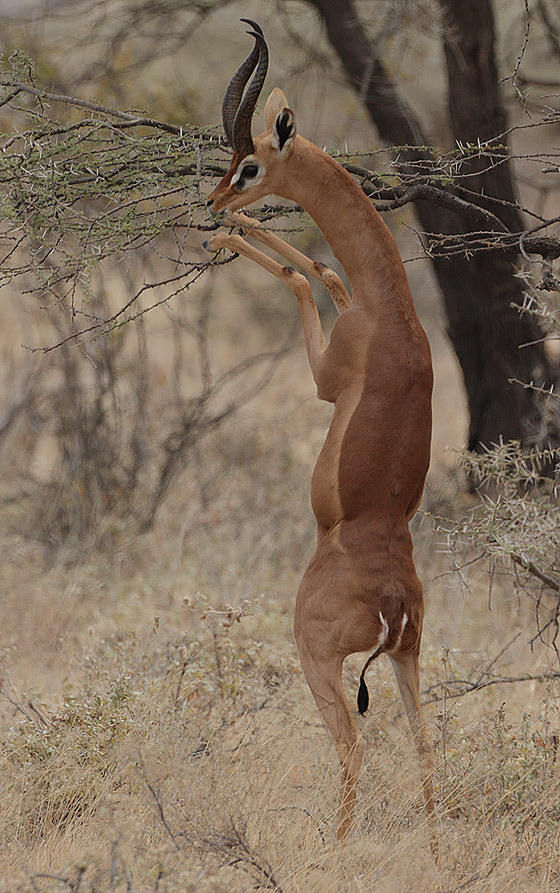
📷2: “Flickr - Rainbirder - Gerenuk male.jpg” by Steve Garvie on Wikimedia Commons (CC BY-SA 2.0)
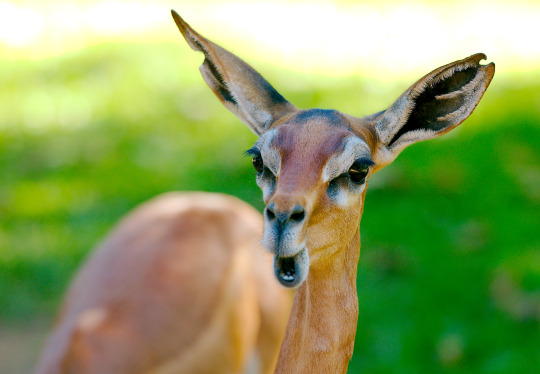
📷3: “Gerenuk (Litocranius walleri)_9” by Josh More on Flickr (CC BY-NC-ND 2.0)
9 notes
·
View notes